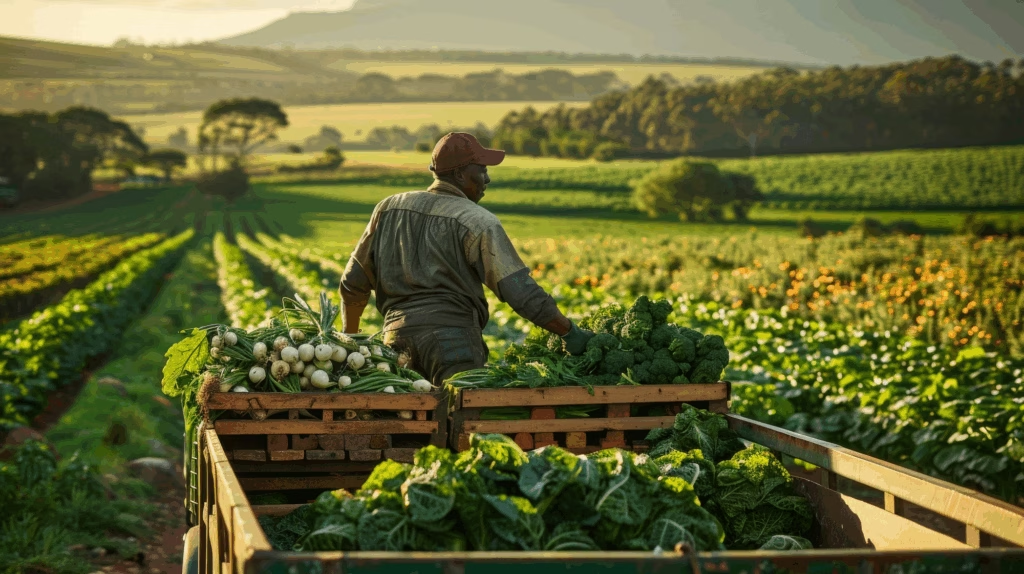Organic farming in the USA is more than just a trend – it’s a growing movement towards sustainable agriculture, healthier food systems, and eco-friendly practices. According to the USDA, organic sales in the United States exceeded $60 billion in 2023, making it one of the fastest-growing sectors in agriculture.

For farmers and consumers alike, understanding the certification process, organic standards, and best practices is key to making informed decisions.
In this guide, we’ll cover:
- What defines organic farming in the USA
- The USDA Organic Certification process
- Core organic farming practices
- Benefits and challenges of organic farming
- Resources to get started
What is Organic Farming in the USA?
Organic farming is a method of agriculture that avoids the use of synthetic fertilizers, pesticides, GMOs, and artificial additives. Instead, it relies on natural methods like crop rotation, composting, green manure, and biological pest control.
The US Department of Agriculture (USDA) regulates organic farming through its National Organic Program (NOP), which ensures consistency and trust in the “USDA Organic” label.
For detailed regulations, visit the USDA National Organic Program.
USDA Organic Certification Process
To sell products as “organic” in the USA, farmers must go through the USDA Organic Certification process. Here’s how it works:
1. Develop an Organic System Plan (OSP)
Farmers must prepare a detailed plan explaining how they will comply with organic standards, including soil fertility, pest control, livestock care, and record-keeping.
2. Apply to a USDA-Accredited Certifying Agent
Applications are submitted to a USDA-accredited body that reviews the farm’s plan and practices.
3. On-Site Inspection
A qualified inspector visits the farm to evaluate soil conditions, crop health, water systems, pest management, and overall compliance.
4. Certification Decision
If the farm meets all standards, it receives certification and can use the USDA Organic Seal.
5. Annual Recertification
Certification isn’t one-time. Farms undergo yearly inspections to maintain their organic status.
Core Practices in Organic Farming
Organic farming in the USA emphasizes soil health, biodiversity, and natural cycles. Some of the key practices include:
1. Crop Rotation & Diversity
Rotating crops improves soil fertility and reduces the risk of pests and diseases.
2. Composting & Natural Fertilizers
Instead of synthetic fertilizers, organic farms use compost, animal manure, and green manure to enrich the soil. (Related: Buy Organic Compost Online in India)
3. Biological Pest Control
Farmers rely on natural predators, beneficial insects, and biopesticides instead of chemicals.
4. Cover Crops
Cover crops such as clover and rye help reduce soil erosion, improve fertility, and support beneficial organisms.
5. Organic Livestock Practices
For livestock to be certified organic, animals must have access to the outdoors, be fed organic feed, and be free from antibiotics or growth hormones.
Benefits of Organic Farming in the USA
- Healthier Food: Free from synthetic chemicals and GMOs.
- Environmental Protection: Promotes soil health, reduces pollution, and conserves biodiversity.
- Market Growth: High consumer demand for organic products in supermarkets and farmers’ markets.
- Premium Prices: Organic farmers often earn higher margins compared to conventional farming.
Challenges in Organic Farming
- High Certification Costs – USDA certification can be expensive for small farmers.
- Labor Intensive – Organic farming requires more manual effort and careful planning.
- Market Competition – With growing demand, more players are entering the organic market.
- Transition Period – It takes at least 3 years to transition conventional land into organic-certified farmland.
How to Get Started with Organic Farming in the USA
- Study the USDA Organic Standards and decide if your farm qualifies.
- Prepare a detailed Organic System Plan (OSP).
- Apply to a USDA-accredited certifier.
- Start small with crops like vegetables, herbs, or fruits.
- Use organic seeds and compost (Related: Buy Vegetable Seeds Online).
For more information, check the Organic Farming Research Foundation.
FAQs on Organic Farming in the USA
Q1. How long does it take to get USDA organic certification?
It usually takes around 3 years to transition from conventional to organic farming, as the land must be free of prohibited substances.
Q2. Can small farmers get financial help for certification?
Yes, the USDA offers the Organic Certification Cost Share Program (OCCSP) that reimburses up to 75% of certification costs.
Q3. Is organic farming profitable in the USA?
Yes, due to premium pricing, organic farming can be more profitable than conventional farming, but it requires more planning and initial investment.
Q4. What is the difference between “natural” and “organic”?
“Organic” is a regulated label under USDA standards, while “natural” is not legally defined and has fewer restrictions.
Conclusion
Organic farming in the USA is shaping the future of agriculture by promoting sustainability, biodiversity, and healthier food systems. With USDA organic certification, farmers gain credibility, market access, and consumer trust.
Whether you’re a farmer looking to switch to organic methods or a consumer seeking healthier food, organic farming plays a vital role in creating a more sustainable future.
If you’re interested in sustainable gardening at home, check out our guide: 10 Easiest Vegetables to Grow at Home.





